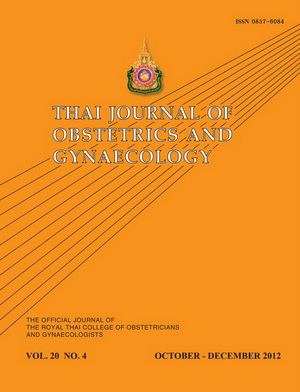Trends of Forceps and Vacuum Deliveries in Rajavithi Hospital from 2002 to 2009
Main Article Content
Abstract
Objectives: To study trends in forceps and vacuum deliveries in both private and hospital cases in Rajavithi Hospital from 2002 to 2009.
Materials and Methods: Singleton, term pregnant women delivered by operative vaginal deliveries from January 1, 2002 to December 31, 2009 were included in this study. Maternal characteristics including types of delivery, private and hospital cases, complications, maternal and neonatal outcomes were compared. Trend in operative vaginal deliveries were analyzed by using linear regression analysis by SPSS version 17.0 for Window.
Results: In 2,723 cases (4.82% of total deliveries) of vaginal operative procedures, 1,808 cases (66.40%) were delivered by forceps extraction and 915 cases (36.60%) were delivered by vacuum extraction. Forceps and vacuum deliveries gradually declined since 2002. Both procedures may approach zero in 6 and 10.5 years (2016 and 2020), respectively, (y= -0.307x+4.434, R2 = 0.715 and y = -0.114x+2.109, R2 = 0.554).In private cases, 274 cases (40.29%) and 406 cases (59.71%) had forceps and vacuum deliveries, respectively. Both procedures may approach zero in 3.20 and 7.53 years (in year 2013 and 2016), respectively. In hospital cases, there were 1,534 cases (75.08%) and 509 cases (24.92%) who had forceps and vacuum deliveries, respectively. Both procedures will approach zero in 7.24 and 10.96 years (2017 and 2020), respectively.
Conclusion: Trends in forceps and vacuum deliveries in Rajavithi Hospital are declining and may approach zero in 6 and 10.5 years, respectively. Trends in private and hospital cases are declining in a similar pattern but at different rate.


